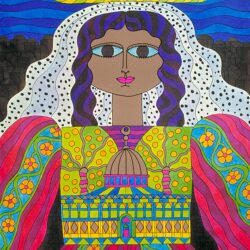Sustainability: On a matter of need - from one use to another

Today, our contemporary world craves sustainability — but when some aim for a zero-waste lifestyle, some are proud to turn off the tap while brushing their teeth. One’s effort reflects one’s involvement, considerations and values, and movements aren’t unified. And still today a grey zone persists: while technology and transportation are commonly agreed as mass polluters because their effects are visible, the fashion industry tends to pass off radars, even though it is part of the top ten most polluting industries in the world. Sustainable fashion is a need, and more and more fashion designers tackle the subject — an issue that isn’t new, as there was a time when recycling and sustainability was a matter of survival in front of a direct, visible threat.
The urgent need for an organized and collective effort

During WWII, Europeans had to continue their life, while being under occupation or at war against the Third Reich. Naval blockades, sieges or enemy requisitions deepened resources’ shortages, and all industries and national decisions were targeted towards the war issues. The fashion industry was not an exception that proves the rule, as nations suffered from material shortages, that the urgency of the situation could not help. To counter those shortages, recycling was a widespread option in those days.


In Great Britain for instance, a specific department had been created in order to nationally organize the collection of recyclable materials, in order to counter their dependency on international imports. Numerous posters were designed to promote the salvaging of raw materials but also objects — like pans or old rags — which were later on transformed into necessary products — just like pantyhoses were asked to be given away to be turned into parachutes.
A democratized take on fashion
This period was also marked by the system of clothing rationing. This restriction aimed at controlling materials’ use and access, money exchanges but also to balance injustices amongst different social classes, by restricting to the minimum the amount of pieces of clothing that could be bought. Scarcity and limitation favored the flight of DIY movements, for example supported by the slogan “Make Do and Mend” in the UK. Whether to be able to dress one’s entire family or to keep a sense of freedom to choose what to wear, imagining new garments or accessories made with what was within reach was a necessity. And when life gives you lemons, make lemonade; to get around shortage: recycle. On upholstery fabric were drawn dresses or coats’ patterns. A man's trousers were dismantled to dress his teenage son. Two moth-eaten jumpers were unravelled and re-knitted together. Patchwork was a common technique.

And if fabrics were requisitioned by the army, they were sometimes recycled one more time, once out of use, by citizens this time. For example, Suzanne — an 18 years-old French woman living in the North of France — was given by an English paratrooper a silk parachute. Amateur seamstress, out of its fabric she could sew no more than a shirt for her husband for their wedding, a part of her wedding dress, a jumpsuit, handkerchieves, a cradle bedding set and a bedspread. Based on common designs, crafting these handmade items was their only way to lay hands on ceremony clothing. Furthermore by the end of the war, reusing surplus clothes was not yet a fad but for some months, still the only alternative to get access to quality garments. And as soldiers’ battledress and civilian men’s suits were adapted to fit their wife, borders between male and female clothing blurred.
A rich page of fashion history
Encouraged by the government or simply because they had no other choice, people had to improve their sewing skills. Consequently, creativity bloomed. Press magazines published patterns and tutorials to guide readers into making their own clothing, jewellery or handbags. And creators too, had to adapt to the material’s availability. Indeed, the Reich and the Vichy Regime in France, deprived designers who did not accept to collaborate of textile. They also imposed regulations on designs and details to control material uses. And if leather were reserved for soldiers, wooden mules made a breakthrough. Marked by its numerous restrictions, this time period was rich in experimentations and innovations.

And when no sartorial option could be found, make up and ink were tools to deceive one’s eye. Therefore giving away their stockings in order to make parachutes, women rather painted a line at the back of their legs, or cover them with “liquid stocking” than walk bare legs.
Dressing properly and holding on creating beautiful and innovative pieces, were during wartime, as much a matter of survival, as an act of resistance; And last but not least they were also symbols of a desire to affirm and maintain pride and dignity — as clothing and garments have often been.





